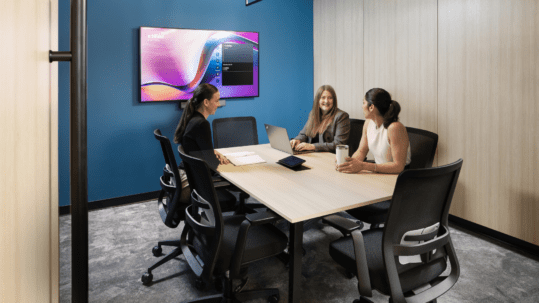There are many reputable studies out there toting the importance and benefits of strong office design strategies contributing to employee retention. This is thanks to an inflated conversation surrounding the relationship of good environmental design factors playing a role in productivity, creativity, and employee well being the workplace, uniting an aesthetically pleasing space with the ability to perform well within it.
But offices in many professional service sectors like law, consulting, real estate, advertising, etc., are tied directly to the customer experience. We believe the same principle of employee retention can be extended to include office design strategy as a key factor for building customer loyalty.
In this post, we’re examining why a strong office design strategy is crucial in building customer loyalty.
Form
It’s 2019 – and the writing is on the wall. Customers and clientele are actively seeking to work with firms and organizations that allow them to recognize an appropriate professional counterpart.
The offices of Apple, Google, and Facebook immediately come to mind for most investigating office design strategy – with Millennial-centric auras, open concept cafes, and collaborative spaces that inspire creativity and chance encounters. While those are admirable and valuable traits – they’re designed for employees – not so much clientele, but this can be extended to customer retention as well. People are primarily visual learners, and when we see something we like, or identify with, it helps us to feel good and confident in our decisions.
Let’s imagine your clients are a youth start up in the real estate sector; say, a budding developer. The youth market has an affinity for eco-efficient and sustainable technologies and actively integrate those styles of technologies and practices into their businesses. Sustainability and creativity are stepping stones to innovation and forward-thinking, two very valuable traits in a collaborating partner. Chances are they won’t be attracted to a dated office space that employs the use of cubicles and a drab paint colour. They’ll be much more receptive and likely to support and continue working with a firm that embraces the aesthetic they identify with as part of their own organizational personality.
More closely investigating the form of your office space is also largely dependant on the footprint of your space. Retention of clientele will always be related to having the physical space needed to accommodate meetings, conferences, video chats, and deliberations – but it’s also about maintaining a space that is sustainable for your needs. There’s little sense in keeping a 3000 square foot office with a 12 person boardroom that sees action 3 or 4 times per year. Instead, maximize your business strategy potential by investigating ways to sustain an attitude based on efficiency and thoughtfulness. Refurbish a large unused space into a collaborative work space for staff, and turn smaller office spaces into private meeting rooms for clients as an alternative to a costly move.
Creating Positive Experiences
Dark and serious offices inspire serious experiences, and business in 2019 is less about the dryness of the old school business world and more so about developing a work/life balance that integrates fun, health, and prosperity through experience
2019 is all about experience-driven spaces that embrace the human potential of industrial and corporate spaces, the goals of which are to improve occupant experience while in the space. Space optimizations that are experience-driven are geared at improving the mental and physical wellbeing of people using the space through community-building.
Imagine you’re courting someone you’re attracted to; you’ll go out of your way to maximize your chances of impressing them with a clean apartment, a spotless car, and by taking them to places that spark some excitement. Take them to boring spots, or back to a messy home, and you can expect they’ll tire of that fairly quickly. Customers and clientele are no different. They expect the image of thier partners and favourite establishments to be refreshing, exciting, and innovative in such a way that it beckons them to come back again and again.
Creating these positive experiences doesn’t have to mean a complete office overhaul – it can mean a dedicated revamp of the lobby or waiting room, of your meeting space to invite them in as friends – rather than just customers; make them feel like valued family members, and they’ll seek out ways to maintain the professional relationship between you.
Readjust Strategy
We can discuss the aesthetic benefits of adjusting and reimagining physical spaces all day – but there’s one surefire way to address client retention through office strategy, and that’s to adjust your strategy all together.
The #1 reason customers leave a company is because they feel the company doesn’t care about them. Nearly 70% of customers polled say dissatisfaction of care contributes to them leaving. The major difference between companies that experience customer retention and those that don’t? Investment in customer retention strategy, not just customer acquisition. Majority of businesses are so enamored with the prospect of attracting new clientele that they leave old or existing customers by the wayside – despite the fact selling to a repeat customer can be up to 7 times cheaper and easier.
Sometimes, investigating office design strategy is as simple as reimagining how you’re thinking in your current space. Giving your staff a creativity-inspiring space to think is as important as trying to attract new customers.
—-
Customer loyalty and retention is all about providing your customers with a space that speaks to the requirements of their collaborating partners. They need a space that compliments their work ethic, their industry, their age, and their speed. But retention is more than that. It’s all about remembering your current customer base, and dedicating your office strategy to evolving with them as they grow and adapt to the marketplace. Office design strategy isn’t always about paint colours and layout – it’s also about learning more about your customers and how they behave.






